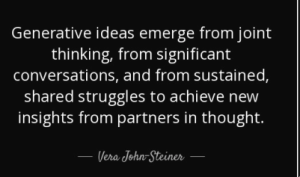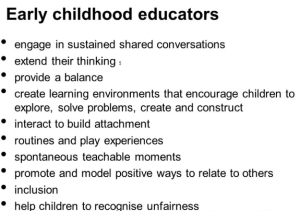‘Sustained shared thinking’ occurs when two or more individuals ‘work 
together’ in an intellectual way to solve a problem, clarify a concept, evaluate an activity, extend a narrative etc.
Both parties must contribute to the thinking and it must develop and extend the understanding. It was more likely to occur when children were interacting 1:1 with an adult or with a single peer p
artner and during focussed group work.
Many theorists believe and research shows that sustained shared thinking is fundamental to how practitioners approach children’s learning and development.
 Sustained shared thinking is best described as those times when you are totally absorbed with a child, in conversation or in an activity with a genuine interest on both parts to find out more.
Sustained shared thinking is best described as those times when you are totally absorbed with a child, in conversation or in an activity with a genuine interest on both parts to find out more.
Sustained shared thinking can happen anytime, anywhere and only requires time and interest on the part of the participants. It can be one to one or in a small group, especially when there is shared group interest. The important aspect is the ‘meeting of minds’ and subsequent learning that occurs on both sides. As a practitioner, you are likely to be aware of a connection and that you and the child/ren are fully engaged in the activity or conversation.
Sustained shared thinking present important opportunities for the practitioner to see a child’s world through their eyes. They will reveal much about the child including their level of cognitive development, schemas and self esteem. The child may also be learning things such as social interaction, a technique, how to think creatively, cause and effect and factual information.
‘In addition to sustained shared thinking, staff engaged in open-ended questioning in the settings where children made the most progress and provided formative feedback to children during activities.
Adult ‘modelling’ skills or appropriate behaviour was often combined with sustained  periods of shared thinking; open-ended questioning and modelling were also associated with better cognitive achievement.
periods of shared thinking; open-ended questioning and modelling were also associated with better cognitive achievement.
Encourage episodes of ‘sustained shared thinking’ with the children.’
Links and further reading
Example of sustained Shared Thinking (Video)
Early Years Forum Article (v. good)
Little Blossom’s Blog – Sustained Shared Thinking
Newsletter article from National Quality Standard on Sustained Shared Thinking
Tip Sheet – Thinking and talking
[slideshare id=64831032&doc=staffmeeting8thaugust2016-160809105618]
Finally… Some examples!
Tuning in: listening carefully to what is being said, observing body language and what the child is doing.
Showing genuine interest: giving their whole attention to the child, maintaining eye contact, affirming, smiling, nodding.
Respecting children’s own decisions and choices by inviting children to elaborate: saying things like ‘I really want to know more about this’ and listening and engaging in the response.
Re-capping: ‘So you think that … ’
Offering the adult’s own experience: ‘I like to listen to music when I cook at home.’
Clarifying ideas: ‘Right Darren, so you think that this stone will melt if I boil it in water?’
Suggesting: ‘You might like to try doing it this way.’
Reminding: ‘Don’t forget that you said that this stone will melt if I boil it.’
Using encouragement to further thinking: ‘You have really thought hard about where to put this door in the palace – where will you put the windows?’
Offering an alternative viewpoint: ‘Maybe Goldilocks wasn’t naughty when she ate the porridge?’
Speculating: ‘Do you think the three bears would have liked Goldilocks to come to live with them as their friend?’
Reciprocating: ‘Thank goodness that you were wearing wellington boots when you jumped in those puddles George. Look at my feet, they are soaking wet!’
Asking open questions: ‘How did you … ?’ ‘Why does this … ?’ ‘What happens next?’ ‘What do you think?’ ‘I wonder what would happen if … ?’
Modelling thinking: ‘I have to think hard about what I do this evening. I need take my library books back to the library and stop off at the supermarket to get some food for tomorrow, but I just won’t have time to do all of these things.’
